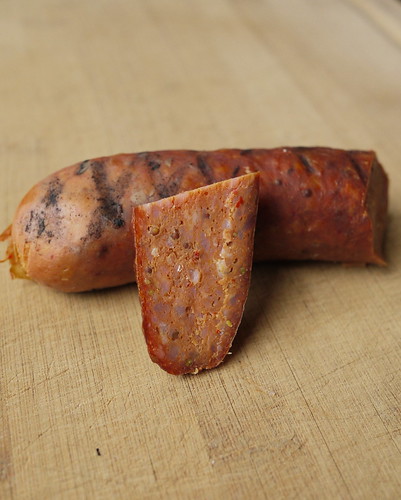
This isn't a story about Korean food. This about catching one of 2012's hottest food trends, Kimchee (Kimchi, 김치). Yes, as reported in Australia and Canada, America will soon be replacing kraut and slaw with the more exotic fermented cabbage to garnish our favorite 'Dude Foods.' Huh. Kimchee came on to my cultural crossing flavor radar last year when the chef, at our humble NW Indiana Brewpub, swapped out the red slaw on our bbq sammie with housemade spicy goodness.
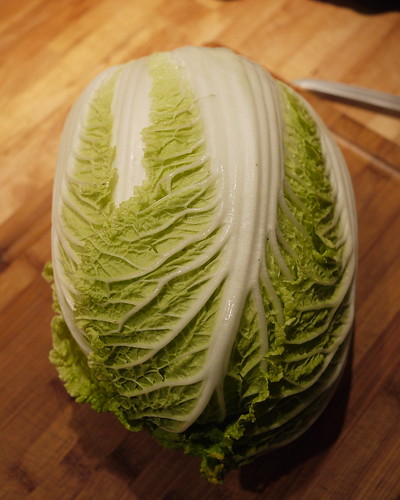
Up to that point I thought that making kimchee was a long process taking months or years involving clay jars and holes in the ground. At the restaurant we made it in 4 days. I started making it at home and I put it on everything.
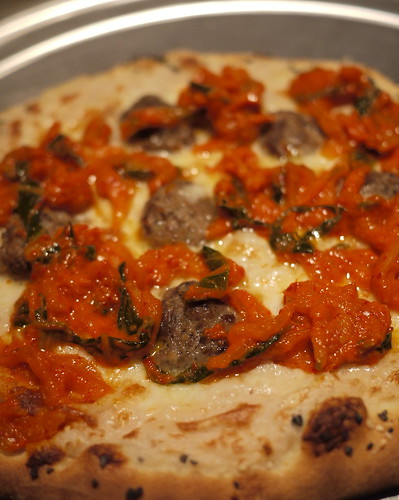
Kimchee on my pizza
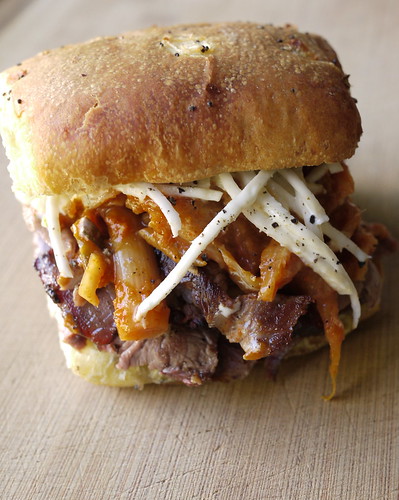
Kimchee on my schwarma
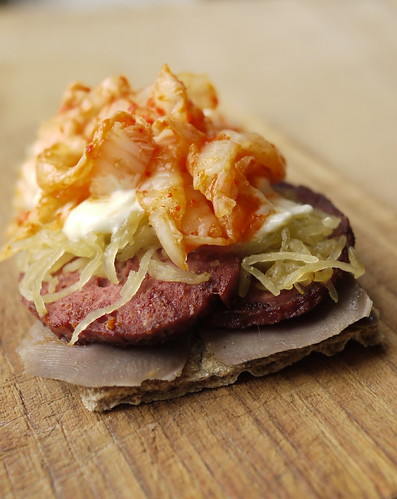
Kimchee on my smörgås.
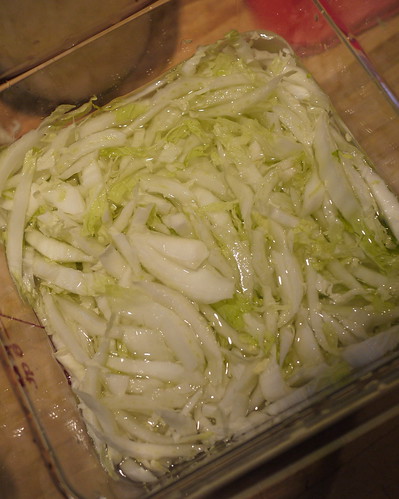
For the kimchee we were making at work, we started by putting thinly sliced Nappa cabbage in a 5% brine, and let it sit on the counter for 24 hours. Then we made what Dave Chang in Lucky Peach #2 calls "The dressing": A puree of red Thai chiles, ginger, garlic, honey and fish sauce. After draining the brined cabbage we tossed it with the dressing, then let it sit for 4 days.
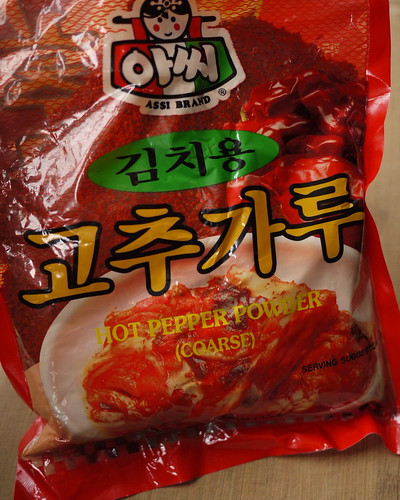
Most recipes call for ground chili flakes called gochugaru (kochukaru, 고추가루). I picked-up a bag to see if it would make any difference for my batches at home. Tasting this particular sample (pictured above) was pretty unremarkable, a cross between crushed red pepper and paprika. Also not spicy at all. While I haven't tried any other brands, and I'm sure there are better, I think half sharp paprika is an spot-on substitute.

I used a combination of both in my batches.

So there are many places you can find a recipe for kimchee, in an effort to stay ahead of the trend, how about a sausage with the dressing on the inside?
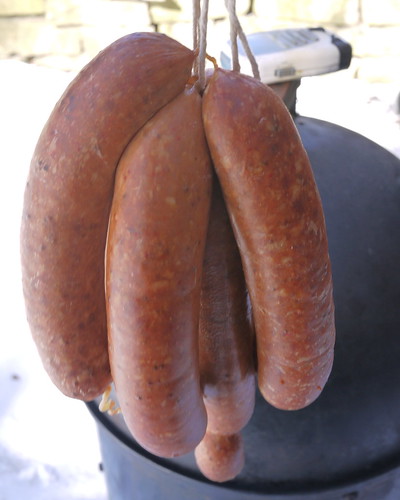
Hello hot link.
Kimchee Hot Link
per 1000g Pork shoulder, cubed and chilled
300 ml cabbage jus
20 ml fish sauce
15 g salt
40 g fresh ginger minced
24 g garlic minced
20 g gochugaru
6 g half sharp paprika
10 g whole brown mustard seeds
20g milk powder
For the cabbage jus: Cabbage has a particular sour/peppery taste, that I wanted in this sausage. Take the whites from a head of bok choy and puree it in the blender, it's ok to add a little water to get it going. Strain the resulting mash through muslin. After cleaning out the blender, add in only 100ml of the jus, salt, fish sauce, garlic, ginger and spices and give the blender a whirl to make a smooth dressing.
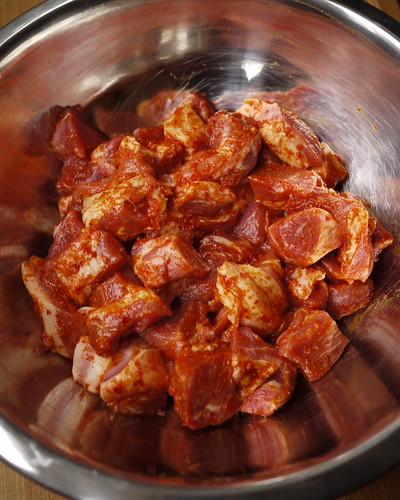
Toss the pork with the dressing and allow to marinate for a few hours.
Grind the pork mixture into a mixing bowl, then beat in the remaining jus and milk powder. Continue to mix to achieve a nice paste. Stuff into prepared hog casings. Try to let the links hang for a day before cooking.
What to do with a hot link, I could just put it on a bun, but wait there's more.

While I couldn't find any corroborating references that this is actually made in Korea, but I found this interesting shape on the website My Fabulous Recipes.
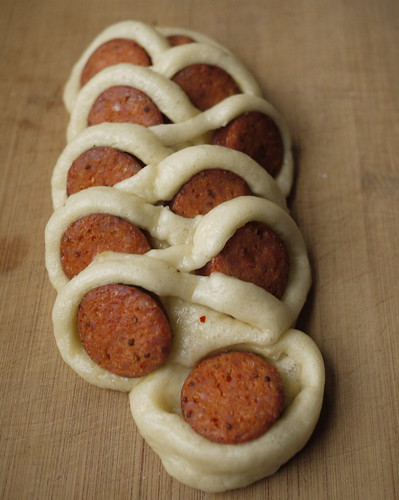
Then I did a steamed one, and then with the help from Asian Dumplings, by Andrea Nguyen, I went dumpling crazy.
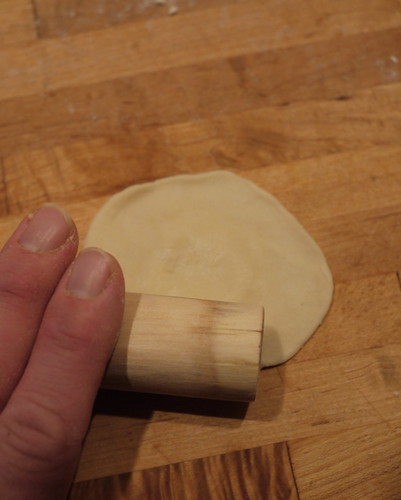
I made a little rolling pin from a dowel.
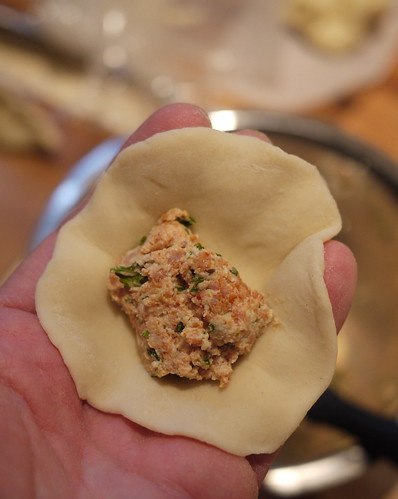
I cut the hot link mixture with some tofu and formed some dumplings
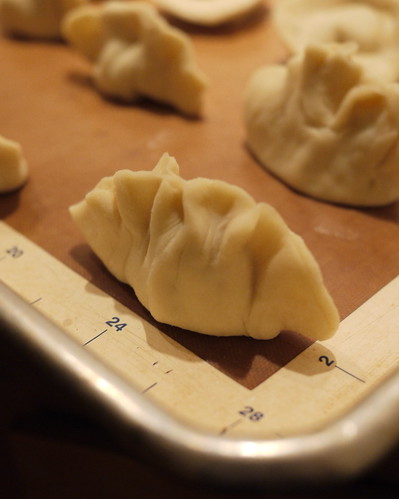

Steamed, jjinmandu (찐만두)
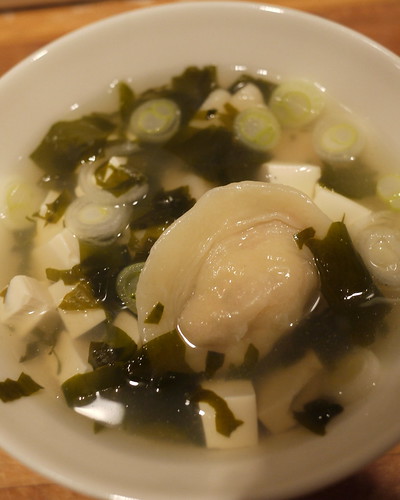
Boiled, mulmandu (물만두)
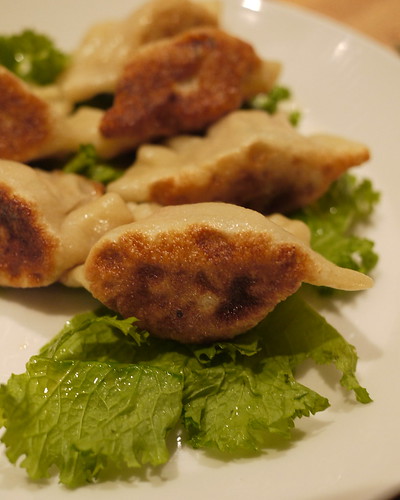
Fried, gunmandu (군만두). These ended up looking like gyōza (餃子). I think they are supposed to be browned on two sides, I'm having trouble reading my translation.

Anyway you slice it, get ahead of the trend and make kimchee hot links today!
Cheers.
Further Reading:
Kimchee's new chapter
Korea's traditional condiment blurring culinary borders by Bill Daley, The Chicago Tribune, 21 September 2011
"Paechu and White Kimchi" by Dave Chang, Lucky Peach Issue 2 Fall/Winter 2011
The kimchi chronicles : Korean cooking for an American kitchen, by Vongerichten
Asian dumplings : mastering gyōza, spring rolls, samosas, and more, by Nguyen
Also check out Nguyen's website, Asian Dumpling Tips
Korean translations via @KoreanFood and Wikipedia
28 February, 2012
Kimchee hot link
23 February, 2012
Coffeehouse hot link

As in the boudin from Louisiana, the kielbasa from Poland, and the saucisse de Toulouse from, well, Toulouse, everybody knows sausage can be from a place, but can it be about a place? I never really thought about it until I ate some cheese.
The cheese I ate had a rind rubbed with coffee and lavender. At first glance the combination seemed curious, I figured it fit in with today's culinary trend of pairing disperate flavors to create new profiles, but I was wrong, the resulting palette was very familiar.
Coffeehouse.
The penultimate coffeehouse experience: It's cold outside, the storefront has fogged up windows, walk in and you are greeted by a rush of humidity and the aroma of coffee, cinnamon and something hippie. Good hippie. And as I tasted the cheese, I realized that 'something hippie' was lavender.
My standard for coffeehouses was set in the late 80's at the King Ave. Coffeehouse in Columbus. It had it all: a bottomless cup, light vegetarian fare, and a bead store off to one side. It's where I learned to drink coffee, It's where felt I could be anything I imagined.
A great memory, but a sausage? Sure why not.

Coffee. I started with brewed espresso (too weak), and I tasted a sprinkle of a fancy-pants instant (too nasty). I settled on a finely ground French roast. For that authentic DIY feel, you could roast your own,but for this project, I used store bought.

Lavender. I found some buds at The Spice House, then pulverized them to a powder.
Let's go to the boards:
1000g Meat. Pork, duck, and/or up to 20% pork fat.
18g Salt
5g French roast coffee beans, finely ground
3g Black pepper
2g lavender, finely ground
pinch of cayenne and cinnamon
50g milk powder (optional)
100ml water (or 85ml water and 15ml vodka)
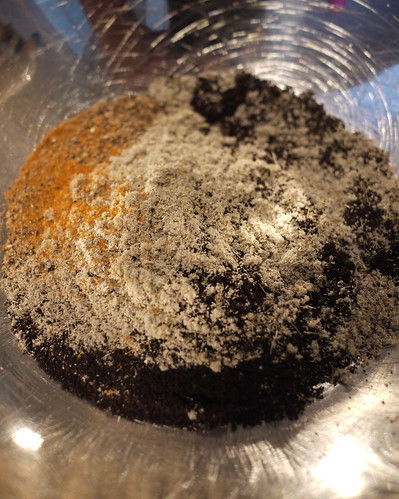
Dice up the meats for grinding. The first time I made it with duck, but pork works very nicely. If using duck, you should add some fat.
After grinding, place meats into chilled bowl and beat in spices, milk powder and liquid. Continue beating to achieve a nice paste. stuff into sheep casings, or roll in plastic.
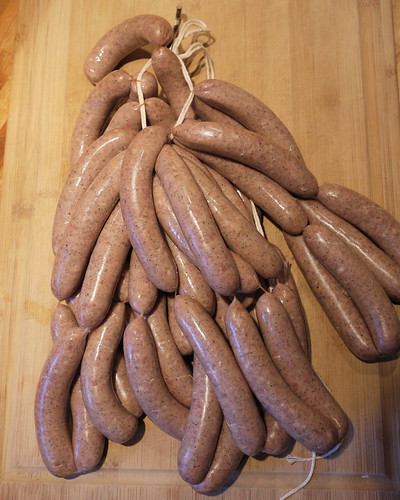
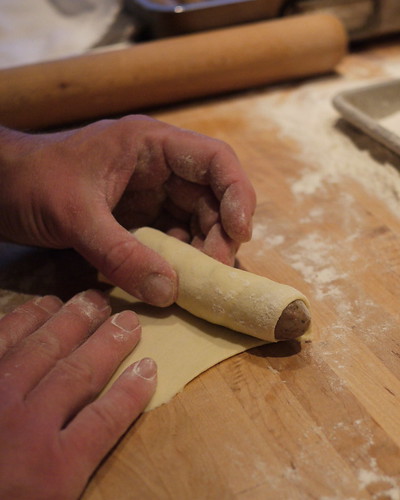
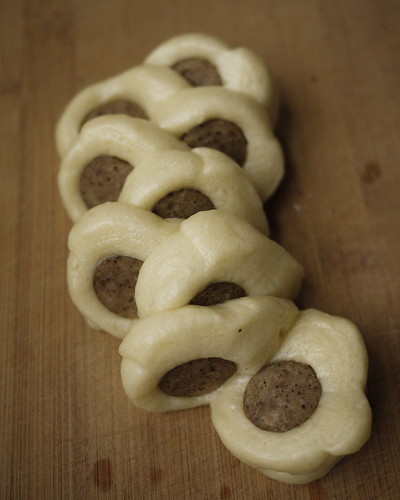
Sausage about place. What do you think? At least it tastes good.
Cheers.
14 February, 2012
Rillettes Encore

Nothing says love like potted pork. I haven't made rillettes in a while and I have forgotten how good they can be. I also had them in a restaurant a few months ago and I was reminded how bad they can be. The secret, don't chop them too long in the cuisinart lest they turn into what Jane Grigson describes as a "Porridge-like slush"
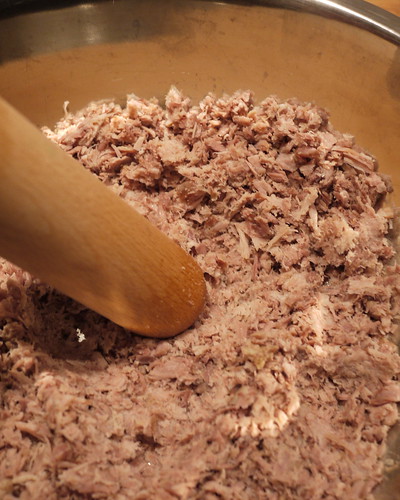
I pounded mine. But wait, this post is running like a Tarantino movie, I've started in the middle, now I've go to flash back to the beginning and work my way to the end.
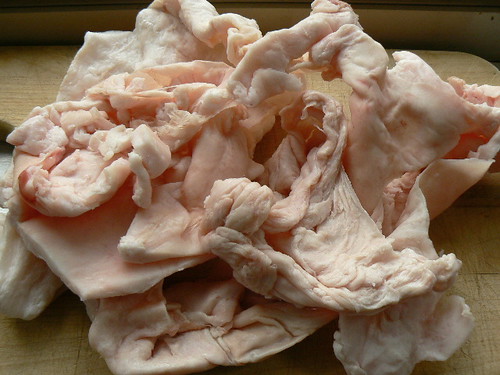
I wrote about rilletes in this post from 2007. Like then, I made lard then slow cooked cubed pork in it. But here's what I did different:
Pre-salting. Nothing new here, Elizabeth David mentions it in her rillettes recipe, I salted at 2% of meat (i.e. 20g for 1000g of pork). I cut the pork into small chunks, salted it and let it sit overnight.
Slooow-cooking and not too long. 200F oven until the pork just falls apart. I did mine for four hours, and they were sightly overcooked. What's overcooked? Dry fluffy fibers that feel like sawdust on the tongue. But don't worry, adding back some melted fat will remedy the situation. Again I am getting to the end when I need to get back to the middle.
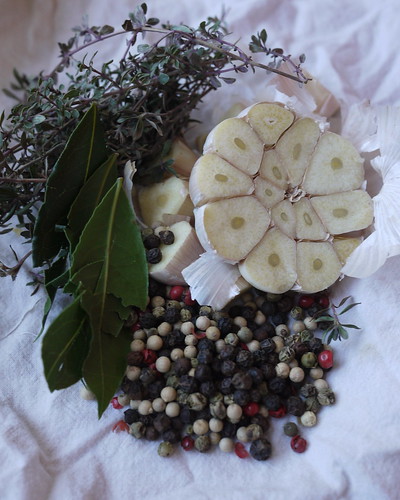
I melted about 1000g of lard for my 1000g of salted cubed pork shoulder. The pork should be completely under the lard. I added a sachet: A bulb of garlic, Handful of peppercorns, fresh bay and thyme tied in a muslin cloth. Place this in a 200F oven for 3 to 4 hours. Once done, drain and reserve lard, discard sachet, and allow the cubes of pork to rest for a half an hour. After resting, mince then pound the pork. While pounding add back some of the reserved lard, to achieve a nice pate. At this point you can add some seasoning, salt, quatre épices or some acid (lemon, wine). I didn't add any of these things, the pork stood on its own. Pack the rilletes into old jam jars or a crock, leave a little headroom then cover with a half an inch of melted lard. Store in the refrigerator, but allow to come to room temperature for service. Put the rillettes out with some pickled veg and grainy mustard. My German pal likes a little lard and rillettes spread on bread with a sprinkle of flaky salt. However you do it make it yours.

Cheers.
Further Reading:
Charcuterie and French Pork Cookery by Grigson
French Provincial Cooking by David
Pork & Sons by Reynaud
Charcuterie by Ruhlman and Polcyn

